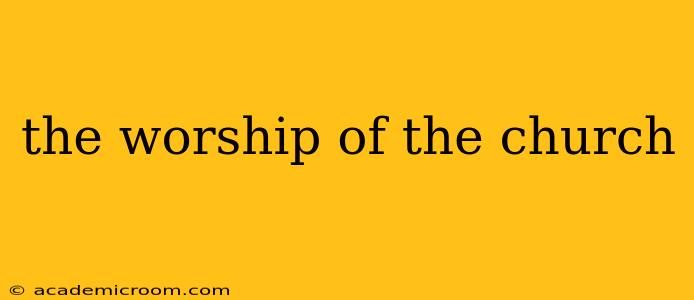The worship of the Church is a multifaceted practice, rich in history, tradition, and theological significance. It's far more than simply attending a service; it's a holistic expression of faith, community, and devotion to God. This exploration will delve into the various aspects of church worship, addressing common questions and providing a comprehensive understanding of its importance for believers.
What are the different types of worship in the Church?
Church worship manifests in diverse forms, shaped by denomination, cultural context, and individual preferences. Some common types include:
-
Liturgical Worship: This style emphasizes established order and structure, often employing a pre-determined order of service with set prayers, hymns, and readings. Examples include the services of the Roman Catholic Church, Eastern Orthodox Churches, and many Anglican and Lutheran traditions. The focus is on the established liturgy as a means of connecting with the sacred.
-
Non-Liturgical Worship: This approach is characterized by more flexibility and spontaneity. Services often involve contemporary music, informal prayers, and extemporaneous preaching. Many Pentecostal, Charismatic, and Non-denominational churches utilize this style. The emphasis here is often on personal experience and the direct relationship between the worshipper and God.
-
Evangelistic Worship: This type is geared towards sharing the Gospel message and inviting people to faith. It frequently involves passionate preaching, powerful music, and a strong call to action.
-
Contemplative Worship: This approach prioritizes quiet reflection, meditation, and prayer, often in a less structured setting. It focuses on individual spiritual growth and communion with God through silence and mindfulness.
What is the purpose of church worship?
The purpose of church worship is multifaceted, encompassing several key elements:
-
Corporate Praise and Thanksgiving: Worship provides a communal setting to express gratitude, adoration, and praise to God. Singing hymns, offering prayers, and participating in liturgical actions collectively deepen the experience of worship.
-
Spiritual Nourishment: Through Scripture readings, sermons, and sacraments (where applicable), believers receive spiritual nourishment and guidance, strengthening their faith and fostering spiritual growth.
-
Fellowship and Community Building: Church worship provides an opportunity for believers to connect with one another, fostering a sense of belonging, support, and shared faith. This strengthens the bonds of the community and creates a supportive environment.
-
Transformation and Sanctification: Engaging in worship is believed to lead to personal transformation and sanctification, aligning one's life more closely with God's will. This is a lifelong process fostered through prayer, reflection, and participation in the community of faith.
-
Mission and Service: Many churches integrate elements of mission and service into their worship, reminding congregants of their responsibility to share their faith and serve others in need.
How can I participate more fully in church worship?
Participating fully in church worship is a journey of personal spiritual growth. Here are some suggestions:
-
Prepare your heart: Before attending, take some time for prayer and reflection, preparing yourself to engage meaningfully with the service.
-
Actively listen: Pay attention to the readings, sermon, and prayers, allowing the message to resonate within you.
-
Participate in the liturgical actions: If your church uses a liturgy, fully engage in the actions and prayers, understanding their meaning and significance.
-
Sing with your heart: Let your voice join the chorus of praise, expressing your gratitude and devotion to God.
-
Offer sincere prayers: Your personal prayers are a powerful element of worship, expressing your needs, concerns, and thanksgiving to God.
What are the different styles of music used in church worship?
The styles of music used in church worship vary widely, reflecting the diverse traditions and preferences within Christianity. From traditional hymns and Gregorian chant to contemporary gospel, praise and worship music, and even world music, the possibilities are vast. The choice of music often reflects the overall style of worship in a particular congregation.
What is the role of the pastor/priest in church worship?
The pastor or priest plays a crucial role in leading and guiding the congregation in worship. Their responsibilities often include:
- Preaching: Delivering a sermon based on scripture, offering theological insights and practical application.
- Leading prayers: Guiding the congregation in corporate prayer and intercessory prayer.
- Administering sacraments: (In some denominations) administering sacraments such as baptism, communion, or confirmation.
- Setting the tone and atmosphere: Creating a reverent and welcoming environment conducive to worship.
The worship of the Church is a dynamic and evolving practice, reflecting the ongoing relationship between believers and God. This exploration serves as an introduction to its many facets, encouraging a deeper engagement with this central aspect of Christian faith. It's a personal journey, shaped by individual experiences and faith traditions, and its richness is discovered through active participation and continual reflection.
